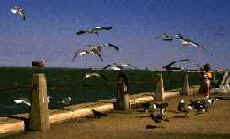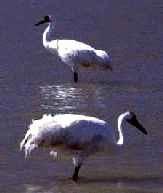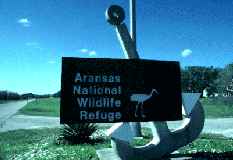TEXAS COASTAL BEND
by Paris Permenter & John Bigley, Texas EditorsThe Coastal Bend has been a magnet for travelers since the days of buccaneers and Spanish conquistadors. Today, drawn by a relaxed atmosphere and a coastal beauty, visitors keep coming, turning the "Island of Texas" into one of the state's top travel destinations.
For nearly every vacationer, the prime attraction is the Gulf shore. "The seashore with the shelling and sunning, that's the big draw," confirms Dave Coggins, president of the Padre Island Business Association. "The real action on the Texas coast is on the barrier islands. And in Corpus Christi, that's Padre Island."
Beyond the small commercial zone, the island gives way to the Padre Island National Seashore, the largest portion of the 113-mile barrier island. Here you'll find mile after mile of undeveloped coastline, much accessible only by four-wheel drive. Enjoy hours of seashell hunting without much competition on the solitary beaches. If you're lucky, you may find glass floats from distant fishing nets.
Year 'round, the Texas Coastal Bend is a region that attracts visitors looking for relaxation, good seafood and a casual seaside atmosphere.
PHOTO CREDIT: PARIS PERMENTER & JOHN BIGLEY
But many of the Coastal Bend's attractions of are of the man-made variety, especially in Corpus Christi. Corpus Christi was charted in 1519 by Spanish explorer Alonzo Alvarez de Pineda, who named the bay Body of Christ, or Corpus Christi. For several years, the coastal area was of interest mainly to pirates, men who used its bay and islands as hideouts.
Today Corpus Christi recalls its maritime history, and the discovery of the New World, at the Corpus Christi Museum of Science. The museum is popular with families thanks to exhibits that include a kids' area filled with marine activities, a natural history and science gallery best known as the home of a live alligator, a shipwreck area where visitors can learn about a 1554 wreck and its victims, and a new exhibit area called Seeds of Change. Originally a Smithsonian display, this permanent exhibit now explains the impact of European discoverers on the New World.
"It really takes you through the environmental and cultural effects of the discovery," explains Lynne Dean, spokesperson for the museum. Along with the 10-minute video, visitors can see a recreation of a slave ship, take a peek in the Montserrat General Store, and learn about changes the discoverers brought, including corn, potatoes, sugar, horses, and disease.
Those discoverers came to the New World by ship, so it's natural that the museum should be home to recreations of the Nina, Pinta and Santa Maria. Docked beside the museum, the ships are open for boarding. The ships and the Seeds of Change exhibits provide a complete look at the time period. "There's nothing like this. It is truly the center of Spanish exploration and discovery," says Dean.
For maritime history of a more recent vintage, travel to the nearby USS Lexington (800-LADY-LEX), the WW II aircraft carrier berthed just offshore. Allow at least two or three hours to fully appreciate the 16-story ship. You'll take a self-guided tour of the 42,000-ton behemoth, but volunteer guides (many who actually served on the Lex) are stationed throughout the ship. They'll be happy to give you personal insights into the ship which served from 1943 to 1991 and was nicknamed the Blue Ghost. The Japanese Tokyo Rose claimed five times that the carrier had been sunk, but each time the rumor proved false. In the end, the carrier went to serve longer than any other vessel in the US Navy.
The Lexington is home to two bonus attractions: helicopter rides and a flight simulator. Both long and short helicopter rides off the flight deck provide a look at the city. Below, the first flight simulator in Texas gives visitors a chance to experience the sensation of a five minute ride in a low flying jet.
After swooping through canyons and coastlines, take a walk from the Lexington to the Texas State Aquarium (2710 Shoreline Dr., 800-477-GULF), where the focus is on sea life of the Gulf and the Caribbean Sea. Over 250 species of marine life are on exhibit here to give visitors a look at the creatures that live below the waves.
To learn more about the wildlife that makes it home along the Coastal Bend, it's time to leave the city and head up the coast to the community of Rockport. Located about 40 miles northeast of Corpus Christi on Aransas Bay, the quiet village of Rockport is the perfect vacation spot for Texans looking for a few days of peace and quiet on the coast.
Rockport is nationally recognized in the birding world because it boasts over 500 species on record. Every fall, visitors from around the country come to Rockport to see the whooping cranes that make their home near Corpus Christi. Capt. Ted's Skimmer (800-338-4551) departs from Rockport to view these endangered birds in their protected habitat. 
See the whooping cranes at Aransas National Wildlife Refuge from November through March.
PHOTO CREDIT: PARIS PERMENTER & JOHN BIGLEY
The birds nest in the Aransas National Wildlife Refuge (512-286-3559), a 54,829-acre park that is the prime wintering ground for the endangered whooping crane, plus hundreds of other bird species. The refuge includes several hiking trails and a paved, 15-mile loop drive for a chance to see some of 80 mammal species indigenous to the region: opossum, shrew, bat, armadillo, raccoon, coati, ringtail, mink, weasel, nutria, skunk, bobcat, white-tailed deer, coyote, and even wild boar. 
The Aransas National Wildlife Refuge and the Texas State Aquarium should not be missed.
PHOTO CREDIT: PARIS PERMENTER & JOHN BIGLEY
The town is well-known as a haven for artists, many exhibiting at the Rockport Art Center. Just down the street, the Texas Maritime Museum covers maritime history from Spanish shipwrecks off the Gulf coast to the offshore oil industry. And if historical homes are your thing, don't miss the Fulton Mansion. Located in the adjoining community of Fulton, this grand home was built in the mid-1870's.
Not far from Rockport, Port Aransas is another popular coastal destination, but with a different slant.
Port Aransas, or just "Port A" to most Texans, is perched on the northern tip of Mustang Island. Because this town's population swells every Spring Break with as many as 150,000 college-aged revelers, the town boasts plenty of accommodations, everything from luxury condominium complexes to Mom and Pop motels aimed at vacationing fishermen. Spend an afternoon out in the Gulf aboard a deep sea fishing cruise. Large group trips, taking as many as 100 passengers, provide bait and tackle, and cost about $20 a day. Serious fishermen looking for big game fish such as marlin and shark should book charter excursions for personalized service.
For More Information:
- Rockport/Fulton Area Chamber of Commerce, 1-800-242-0071
- Port Aransas Tourist and Convention Bureau, 1-800-45-COAST
- Corpus Christi Area Convention and Tourist Bureau1-800-678-OCEAN
